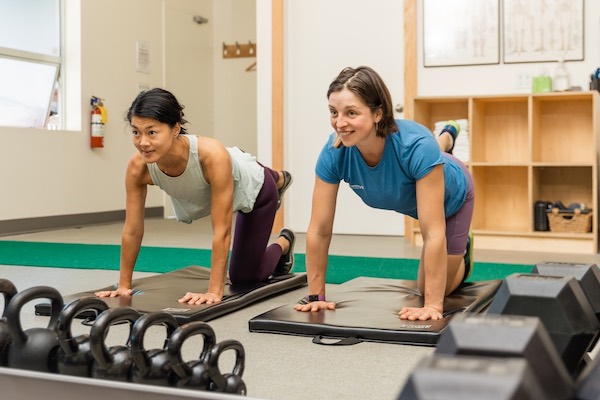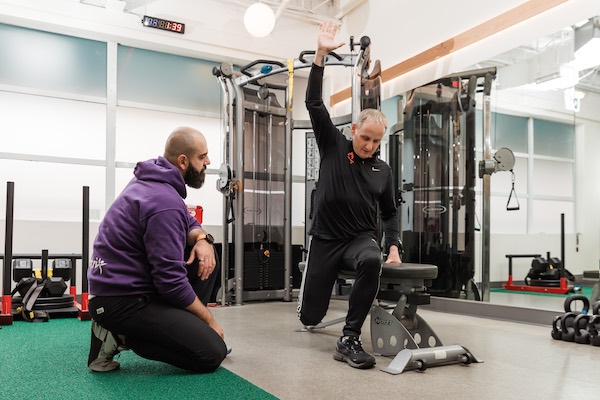Aging is an inevitable and complex process that affects the human body in various ways, including changes in mobility and functionality. As we age, there are physiological alterations that impact our musculoskeletal system, nervous system, and overall physical function. However, through the application of kinesiology-based exercises and lifestyle modifications, we can promote healthy aging, preserve muscle strength, and maintain independence, allowing us to age gracefully and lead fulfilling lives.

Effects of Aging on Mobility and Functionality
Muscle Mass and Strength Loss (Sarcopenia)
Sarcopenia is a condition characterized by the progressive loss of muscle mass and strength. With aging, there is a decline in muscle protein synthesis, which is the process that builds and repairs muscle tissues. Additionally, an increase in muscle breakdown occurs. These changes contribute to reduced muscle mass and weakened muscle fibers, leading to difficulties in performing daily activities such as walking, climbing stairs, and lifting objects. Loss of muscle strength can result in a decline in functional abilities and increased dependency on others for everyday tasks.
Joint Changes and Reduced Range of Motion
Aging can lead to wear and tear on joint cartilage, a decrease in the production of synovial fluid, a reduction in collagen production and stiffening of ligaments. Cartilage serves as a cushion between bones, and synovial fluid lubricates the joints for smooth movements. As these components deteriorate with age, joint flexibility and range of motion are compromised. Joint stiffness can make movements less fluid and more challenging, impacting overall mobility and reducing the ability to perform daily tasks with ease.
Balance and Coordination Decline
The aging process can affect the sensory receptors responsible for balance and coordination. Inner ear changes and alterations in sensory feedback can lead to reduced proprioception (awareness of body position) and impaired postural stability. As a result, older adults may experience balance-related issues, increasing the risk of falls. These challenges in balance and coordination can significantly impact mobility and independence in older adults, affecting their confidence in moving safely.
Bone Density Loss (Osteoporosis)
Osteoporosis is a condition characterized by reduced bone density and increased bone fragility. With aging, bone remodeling becomes less efficient, leading to a greater rate of bone resorption than formation. The bones become weaker and more susceptible to fractures, particularly in weight-bearing joints like the hips, spine, and wrists. Fractures can severely compromise mobility, cause pain, and lead to a loss of independence.
Neurological Changes
Aging can lead to alterations in the nervous system, including a reduction in the number of nerve cells and a decline in nerve conduction speed. These changes can affect motor control and coordination, leading to mobility challenges. Slow nerve conduction can result in delayed muscle responses, affecting balance and gait. Moreover, reduced nerve cells can influence muscle activation patterns, leading to changes in movement efficiency.
Cardiovascular Changes
As we age, there may be changes in the cardiovascular system, including a decrease in heart muscle elasticity and reduced maximum heart rate during exercise. These changes can lead to reduced cardiovascular endurance and overall physical capacity. As a result, activities that once were easily manageable may become more challenging, impacting overall functional abilities.
Combined these degenerative changes make older adults much more susceptible to falls, and loss of function in their day to day lives. The science community otfen points out the correlation between living longer and having increased leg strength. The stronger and more mobile you are, the less like you are to fall and break a hip. The stronger you are the more likely you are to go grocery shopping, play with your grandchildren and live a fulfilling life.
Kinesiology-Based Approaches for Healthy Aging
All these changes due to may sounds very scary, but not to worry we can slow down these degenerative changes through working on the correct types of exercises. This is where kinesiologist shine! They have the right education, tools and expertise to help slow down aging and help us maintain our function throughout our lives.

Strength Training
Kinesiology-informed strength training routines assume a vital role in advancing healthy aging. By concentrating on resistance exercises that target key muscle groups, carried out at a suitable intensity and frequency, the growth of muscles and the retention of muscle mass can be prompted. This approach effectively combats sarcopenia while sustaining overall strength and functional capacity. It is noteworthy that the differentiation between fast twitch and slow twitch muscle fibers is pivotal. Fast twitch fibers are responsible for explosive power and strength, while slow twitch fibers are geared towards endurance and stamina. Interestingly, the decline in strength observed, particularly in fast twitch fibers, is attributed more to underutilization rather than solely to aging. Research from the 1990s has even shown that appropriate resistance training can trigger improvements in fast twitch muscle fibers. This signifies that through well-designed kinesiology-based programs, individuals can rejuvenate their fast twitch fibers, hence enhancing their strength and overall physical capabilities as they age.
Cardiovascular Activities
Cardiovascular exercises, such as walking, swimming, or cycling, help improve cardiovascular health and boost endurance, supporting overall fitness levels and mobility. Cardiovascular activities can also promote heart health, reducing the risk of cardiovascular diseases.
Balance Training
Balance training is of paramount importance for older adults as it plays a pivotal role in maintaining their overall well-being and reducing the risk of falls and injuries. As individuals age, their balance and coordination naturally decline, making them more susceptible to accidents that can have severe consequences. Engaging in targeted kinesiologist prescribed balance exercises helps older adults enhance their stability and proprioception, thus bolstering their confidence in everyday activities. These exercises often include activities such as standing on one leg, heel-to-toe walks, and single leg poses that challenge equilibrium. By focusing on balance training, older adults can regain a sense of control over their bodies, enhance muscle strength, and foster better posture, ultimately leading to a more active and independent lifestyle in their golden years.

Flexibility Training
Flexibility training holds a pivotal role in promoting the overall health and well-being of older adults. As individuals age, their muscles and joints tend to lose elasticity, leading to reduced range of motion and an increased risk of stiffness and discomfort. A kinesiologist can help create a regular flexibility routine to help counteract this natural decline by stretching and lengthening muscles, tendons, and ligaments. Activities such as gentle yoga, static and dynamic stretching can significantly improve flexibility, making daily tasks easier and more comfortable to perform. Moreover, flexibility training can alleviate joint pain, enhance circulation, and improve posture, all of which contribute to a higher quality of life for older adults. By incorporating flexibility exercises into their routine, older individuals can maintain their independence, move with greater ease, and enjoy an active lifestyle well into their later years. Additionally, kinesiologists have tools like foam rollers which can help people gain more flexibility.
Functional Training
Functional exercises involve performing movements that mimic activities of daily living. These exercises help older adults maintain independence by enhancing their ability to perform everyday tasks safely and effectively. Functional training enhances coordination and strengthens muscles used in everyday activities, supporting overall mobility and functionality. For example, carrying grocery bags, or lifting a box over head. A kinesiologist is well suited to aid in this type of exercise.
Posture and Core Strengthening
Focusing on maintaining proper posture and strengthening the core muscles can alleviate pain and improve overall body stability, contributing to better mobility and functionality. Core strength supports the spine and pelvis, enhancing balance and preventing falls.

Conclusion
Aging gracefully is about embracing the natural changes that come with time while taking proactive steps to maintain mobility and functionality. Kinesiology-based exercises, combined with lifestyle modifications, can be powerful tools to support healthy aging, preserve muscle strength, and promote independence. By incorporating these practices into our lives, we can continue to lead active, fulfilling lives as we age gracefully. Find out more about kinesiology here.




.jpg)



